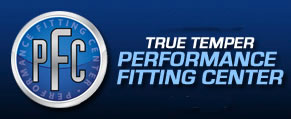CLUBFITTING TERMS AND CONCEPTS
This web page is in response to frequent questions about clubfitting that we hear from the golfers we meet. We hope our answers help take the mystery out of getting fit for clubs and how clubs affect the gofl swing
SET MAKEUP. An optimum set has only the right clubs needed to fit your game on the courses you play. Your clubmaker can help find the best combination of clubs to put in the bag. If you have difficulty hitting a 4-iron, don’t get one. If an extra wedge would help your short game, get it. If brand name is a key consideration, be sure the model you want is right for you -- most brands, OEM or component, have models designed for particular skill levels and swing styles. Clubfitting will help you select the right model and specifications. How much to spend on each club? Well, how important is it to your game and how many strokes/swings do you make with it?
LENGTH. One of the most important specifications of a golf club is overall length. Optimum length for any club is what it takes to hit the ball in the center of the club face consistently. Length has major effects on distance, accuracy and feel. It’s interesting to note that the average length of a driver on the main pro tours is about 44.5 inches. If your driver is longer, try dropping down to 44.5 inches or less for greater accuracy. Consider whether you score lower by hitting your tee shot into the fairway and controlling the approach shot or bombing and gouging from the rough. Why use a longer driver than the best players on the planet? OEM marketing is probably the main reason you do it. And what about irons? The common half-inch length difference in off-the-rack irons forces you to make minor adjustments in setup at address which does not help your consistency. We can correct for this problem in a custom set.
LOFT. The loft of a club face is the key design factor in achieving maximum distance for any speed. Loft works by contributing to the launch angle and backspin of the ball. Loft contributes more to ball trajectory than shaft flex. If you hit a 3-wood as far as your driver, you may not have enough loft in your driver for your swing, or you may not be making good contact with the ball. Most pros on tour and on the long drive circuit hit the ball on the upswing (positive angle of attack): that’s why they can use lower-lofted drivers. If you still need convincing try this experiment: next time you use a garden hose to wash your car think of the nozzle as the club head and water as ball speed and see how launch angle works with speed to yield distance. Then get yourself a driver with the right loft - you’ll have “scientific evidence “ on your side when you look for a driver with a double-digit loft angle.
BACKSPIN. It’s the backwards rotation component of ball spin (around an axis of rotation) during ball flight resulting mainly from the ball sliding up the club face upon impact. At any swing speed, higher loft angles induce greater backspin: shaft flex also contributes to spin rate. Backspin contributes to increased airflow over the surface of the ball enhancing air pressure differences that lift the ball. Dimples on the ball surface also influence the airfoil effect that lifts the ball and keeps it in the air longer. Too much backspin causes the ball to balloon upwards and lose distance; too little backspin and the ball does not reach an optimum trajectory and distance is lost. The top edge of a groove can contribute to backspin. The major contribution of grooves to backspin is on short irons and especially wedges. On a driver, grooves are mainly cosmetic. A major function for grooves is to trap grass and water.
TOTAL WEIGHT. The total weight of a club has a major effect on performance and feel. A lightweight club is easier to swing and thereby helps increase club head speed, but it might be more difficult to control and keep on plane. A heavier club weight helps control tempo and timing to improve accuracy. Club head weights are standard for a given loft, and standard grip weights fall within a narrow range. However, shafts are available with weights that vary by 50 g or more making shaft weight a major contributor to total club weight: shaft weight has a major effect on the driver, the lightest club in your bag. Weight and where it’s distributed in a club have a major influence on clubhead speed and shotmaking accuracy.
SWINGWEIGHT. It is an expression of how weight is distributed along the club relative to a standard fulcrum point; and it is important in club feel. More weight in the club head end increases swingweight whereas more weight in the grip end decreases swingweight. Measurement of swingweight is usually done on a balance beam with the fulcrum at 14 inches from the grip end of the club; and it’s expressed by a letter-number combination. You probably won’t see a club lighter than B1 or heavier than F1. Men’s clubs on average are built to be C9 - D3 and women’s clubs at C5-C8, but there is no fixed standard. Swingweight matching to the same value was originally intended to make the clubs in a set have a consistent feel. However, current understanding of the golf swing shows that matching to a constant moment of inertia yields a better feel and greater consistency through a set of clubs.
M.O.I. (Moment of Inertia). We learned in physics classes that MOI is the resistance of an object to being put into motion when an external force is applied - high MOI means more resistance. MOI is used in golf in a couple of different ways. For describing a club head (putters and drivers get most of the attention), MOI can refer to the resistance of the clubhead to rotation/twisting at impact - high MOI in a driver is good to minimize shot dispersion. MOI of the entire club measured at the grip end can also be done and used for MOI matching of any number of clubs, and it’s the best way to match feel throughout a set of irons -- constant MOI is good. Our performance-based fitting identifies key club parameters that give you consistent center impact of the ball on the clubface with our test clubs. Then, we measure the MOI and build your custom clubs to the same MOI. Every club in an MOI-matched set of irons will feel the same in your swing allowing for a more consistency, thereby improving tempo and timing. Golfers who play with MOI-matched clubs prefer them to traditional swingweight matched clubs.
CENTER OF GRAVITY (CG). It is the point where all planes of balance intersect, and it’s a consequence of how weight is distributed in a club head or club. Maximum energy transfer in a swing results when the CG of the club head is directly behind the ball’s center on the target line. A club head with the CG below the CG of the ball at impact will increase the trajectory of the ball. If the CG is fixed in place and club head weight is moved to the perimeter (sides or back) MOI is increased; and that’s the main goal of several cavity back designs in irons and many exotic designs in putters.
SHAFT FLEX. As you might suspect, shaft flex is an important factor in the feel and performance of a club, and it also contributes to ball spin rate. In nearly all sets, flex varies with club length in accordance with specific performance goals. Although most shaft makers classify flex using the same terms, there are no standards. That’s right - what’s regular to one company may not be regular to another company and neither one may be regular for you, so what’s regular anyway? A common way to determine flex is to clamp the shaft at the butt end; add a weight to the tip then deflect and release. The resulting shaft oscillation is measured in cpm with a frequency analyzer. The Braly flex designation (based on a 2.5” shaft clamp) was perhaps the first successful way to describe a shaft’s flex property and it continues today in Rifle and Project X shafts. The PCS offered an alternative system (based on a 5” clamp) with different values to describe a particular flex. It’s common to find a manufacturer’s flex rating to be off commonly used standards by up to 1 - 2 flex ranges. Most modern shafts are designed to have distinct flex properties throught the length of the shaft (e.g., butt, middle, and tip sections) since different regions contribute distinctly to performance and feel. A “hinge” section may be incorporated and it’s location will influence the overall flex effect. Measurement of flex at multiple points along the shaft gives a bending profile making it possible to refine shaft matching and optimize performance features in a club set. However, flex/frequency measurements are relatively low in resolution and the “moving” clamp distorts the characterization of stiffness that’s designed into modern shafts. Modern shaft design is based on EI stiffness factors (see below) that provide a more accurate basis for understanding flex behavior.
EI CURVE. It’s a graphical representation of the change in shaft stiffness through the length of a shaft. We like to think of it as a detailed stiffness profile that helps us understand the behavior of a shaft during the golf swing. EI is the acronym for elasticity inertia (modulus of elasticity vs. area moment of inertia vs. length). Modern engineers design shafts to achieve a desired EI profile by selective use of various materials and production techniques. The goal is to complement particular swing characteristics to achieve a desired ball flight. Stiffness is measured by the resistance of the shaft to a constant weight load applied to a point of typically at one-inch intervals along the shaft. EI curves provide high resolution descriptions of shaft stiffness that reveal design details not shown by low resolution measurements of flex (the common L, A, R, S, X designation) or vibrational frequency (in cpm) or the long outdated concept of kick point.
FREQUENCY MATCHING. Shaft frequency is a measurement of shaft flex. In frequency matching, the flex of each shaft within a set is matched graphing vibration frequency versus club length. A linear flex slope is common but not always desirable -- there are no rules here. That’s where knowledgeable clubfitting enters the picture. A similar approach can be taken with EI curves and the ultimate set will have certified EI-matched shafts. In building your clubs, if the shafts are just pulled out of a box, trimmed to length using a template, and epoxied into the heads -- “cut and glue” -- you are likely to see frequencies that vary considerably, often to the detriment of your game. If you’ve watched any videos of iron sets built this way in a factory, you can understand why mass assembled clubs can feel and perform differently than the demo club you tested.
BEND POINT. It is the position of maximum bending along a shaft that’s measured when it’s ends are compressed towards each other. The difference between high and low bend points may be less than 2 inches at a region near the middle of the shaft, and it affects launch angle by less than 1 degree. Some golfers claim low bend point shafts have a more solid feel when contacting the ball in a swing. Bottom line: bend point is an outdated measurement that doesn’t provide meaningful information on how flex is distributed along the shaft, and its effect on trajectory is overstated. Shaft bending can also be measured by clamping the butt and deflecting the tip with a constant force. The position of maximum bending by this approach is the KICK POINT, and it’s located near the bend point. Neither measurement significantly predicts shaft performance, but marketing folks like these terms.
SPINES. Shafts can have slight construction irregularities resulting from the manufacturing process itself. If you check shaft oscillation at different rotational positions you are likely to see changes in vibration frequency that can vary by as much as a whole flex rating or more in some graphite shafts and somewhat less in steel shafts. Different techniques get this information and each procedure has its advocates. You almost always find two or more different orientations where shaft oscillation is stable and vibrates on plane; in between those orientations the shaft might wobble substantially. Most of us want a stable plane aligned along the target line (perpendicular to the club face) when the shaft is mounted in the hosel. The graphics on a shaft might not be lined up with the stable oscillation plane. If there is residual bend in the shaft from it’s manufacture, the spine and the stable plane of vibration may not be the same. A simple spine finder in this case will be influenced by residual bend and “spining” may not be sufficient for optimum shaft alignment in the clubhead.
TORQUE. It is a measure (in degrees of rotation) of a shaft’s resistance to twist. During a swing a club head will exert twisting forces on the shaft because the head’s center of gravity is not in line with the shaft, and it’s aggravated by an additional rotational force around the club head’s center of gravity. These forces affect ball flight, especially on off-center contacts. A shaft with lower degrees of torque does not twist as easily and will feel more stiff than a shaft with higher degrees of torque at the same flex frequency. Torque varies with shaft length. There are no standards of measurement for torque, making comparisons between shaft brands difficult. Unless you have a high swing speed and a late release, torque is mainly important for feel. Shaft feel comes largely from the interaction of torque and bending flex. Excessive tip trimming of a shaft can change torque in this region more than the shaft designers intended and result in a “boardy” feeling that reduces the performance of the shaft.
LAUNCH ANGLE. It is the angle between the ball’s line of flight and the ground measured immediately after impact. It’s determined by the dynamic loft that comes from the combined effects of club face loft, the angle of attack (the vertical angle of the club head relative to the ground at impact), ballspin components, club center of gravity, and shaft flex. High positive angle of attack and low clubface loft is the secret to those amazing LPGA driver distances. A downward angle of attack adds backspin to the ball and can cost you distance. That’s why measuring the angle of attack, along with ball contact location on the clubface, is essential to driver fitting.
LIE ANGLE. It is the angle formed between the centerline of the hosel and the ground when the middle of the sole at the center of club face is in contact with the ground (a “flat” lie). Lie is a major factor for accuracy in short irons, a moderate factor in mid-lengthand long irons, and it’s often ignored in hybrids and woods since they are difficult if not impossible to adjust unless that capability has been engineered into the design. If the toe of an iron or putter points up too much at address, the club face tilts slightly left and that’s where the ball will go; if the heel is raised, the club face tilts right and the ball will go right. When lie is adjusted correctly, the club face will be aimed on the target line at impact when the sole rests on the ground. Measurement of lie angle is best when it’s based on how the ball contacts the clubface not on how the sole of the club contacts a hard surface -- the traditional lie board can cause as many problems as it fixes.
FACE ANGLE. Drivers and other woods are often designed with the club face pointing slightly away from the target line when the club is grounded at address and the hosel is kept perpendicular to the target line, When the face points left we call it closed, and when the face points right we call it open. You can probably figure out where it points when we call it square. A closed face angle can help to correct a slice that just won’t go away. (You can talk to a slice but it might not listen.)
OFFSET. The distance from club face leading edge to hosel leading edge is hosel offset, and from club face leading edge to hosel centerline is face progression. A club head with less offset small numbers) will have more face progression (bigger numbers). Many folks in the golf business get this relationship confused. Since hosel diameters can vary between brands, FACE PROGRESSION is a better term to use when designing or comparing clubs. More hosel offset may help in bringing the club face back to square at ball contact, and the corresponding movement of the CG backwards can increase ball trajectory. Since the effects are greater for longer clubs, progressively increased offset is often designed into longer clubs. Offset is a common feature of game improvement clubs, but the benefits are minimal if the shaft is too stiff or club release is too early. The offset look at address can be a confidence builder.
BULGE and ROLL. They are features of woods -- irons, wedges, and putters have a flat face. Bulge is the horizontal curvature seen on a wood face, and it helps to counteract unintended effects of side spin caused when a ball is hit off center on the club face. Roll is vertical curvature. On large driver faces, roll above the center of the club face may increase loft up to 3 degrees; roll can decrease loft similarly below the club face center. That’s part of the reason ball contact on the heel or toe adds spin and changes the trajectory of the ball.
GRIPS. They have a major effect on the feel of a club as you might expect. The average men’s grip weighs about 50 g, and the weight range of most current grip styles is about +/- 10 g. Grips that are too small or too large will cause increased tension in the hands and arms that will impede a smooth flowing swing and optimum wrist action. As little as 1/64 inch in diameter can make a difference for many of us. Consider a different style when you replace worn grips to try a different feel. Many composite materials minimize shock and vibration to benefit joints and tendons.
FEEL. It’s important. It’s an undefinable holy grail of clubfitting - we all understand distance and accuracy, but when it comes to feel most of us can’t describe it yet we know when it’s right. A good clubfitter/clubmaker will help you find it through an understanding of shaft flex and torque, club weight and balance, grip types, and club head design. If your clubs don’t feel great, get new ones.
D-PLANE. It is a concept based on geometry that describes how the initial flight of the ball is determined by where the club face is pointing and by the direction of the club path at impact. Analysis with radar-based launch monitors shows that face angle at impact is the major influence (about 80 %) on the initial direction of the ball. The term “D Plane” comes from “The Physics of Golf” by T.P. Jorgensen in describing the forces that determine ball flight. He used classic geometry: two intersecting lines determine a plane -- the club path defines one line, and the direction perpendicular to the club face at impact defines the other line. The initial flight of the ball lies between the lines in that plane, and is closest to the club face line. The plane will be tilted by spin forces (e.g., side-spin) on the ball, and the amount of tilt will correspond to the sideways curve of the ball in flight. The D-Plane provides a more accurate basis for understanding ball flight physics of a slice or hook than suggested by early empirical classic ball flight laws.
SPINE ANGLE. Analysis of an efficient golf posture characteristic of top skilled players shows the spine angle will be in an optimum range for forward bend and side bend at address, that these angles change as the spine rotates through the swing, and that there is an optimum rotational angle. These angles are influenced somewhat by individual physique, golf fitness, and clubs. Modern biomechanics shows that many swing faults are associated with deviations from these optimal ranges. Changes in these angles are difficult to measure without using inertial sensors or the equivalent, and can be missed by relying on visual analysis. One of the benefits of 3D motion analysis is getting these measurements right and relating them to your particular swing traits.









